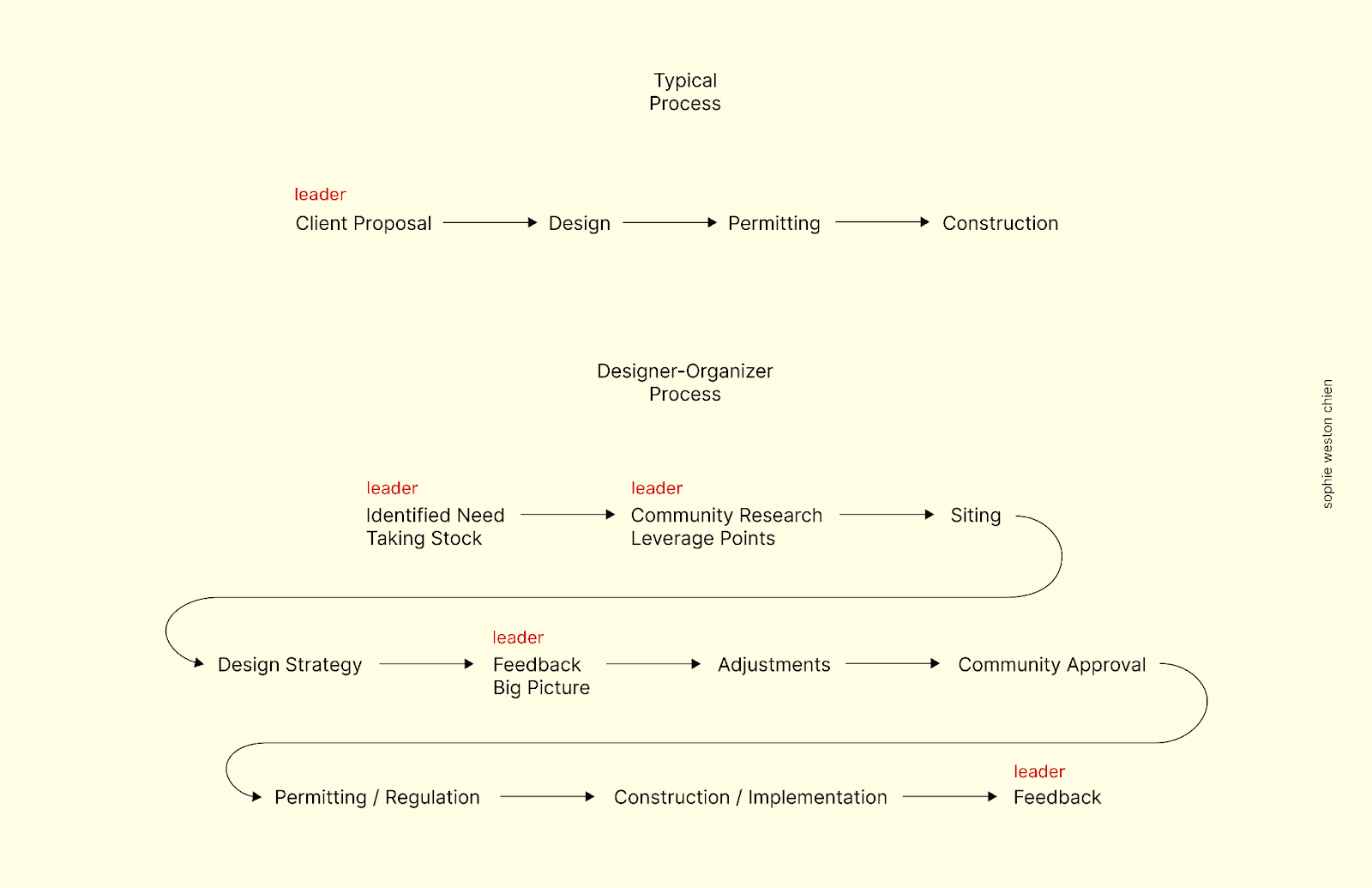Design-Organizing Abolitionist Futures
Contributor
Abolition in Practice?
Design-Organizing Abolitionist Futures
Sophie Weston Chien
First, let’s start as professionals do—with construction documents. Landscape architect and author of Professional Practice of Landscape Architecture, Walter Rogers, writes, “Construction documentation is a critical component of the construction contract process and, therefore, has legal ramifications.”1 Along with specification sheets, construction documents are legal contracts that bind a designer’s work to their clients, record design services, and can be used to prove liability if anything goes wrong.
Second, let’s acknowledge that it is an artifice that the professional practice of landscape architecture cannot be radical or perform radical acts. According to the American Society of Landscape Architects, the profession of landscape architecture involves planning, designing, management, and nurturing of the built and natural environments. They suggest that, with their unique skill set, landscape architects work to “improve human and environmental health in all communities.”2 So, it must be asked: What tools of a contemporary landscape architect enable us to fulfill this responsibility?
Concurrently evaluating the tools and stated values of landscape architecture (or, for that matter, any professional design or planning degree) is a sobering exercise. The disciplinary tools of the profession are unable to adequately and precisely enact the types of repair, harm-reduction, and growth required to improve health in all communities. Moreover, as the discipline represents itself, it is also clear that the professional practice of landscape architecture is not currently radical or emboldened to perform radical acts.
As organizer Grace Lee Boggs reminds us, “Visionary organizing gives you the opportunity to encourage the creative capacity in people.”3 I am joining the call of so many before me to use the tools of a design degree to move hearts and minds. However, I am also calling to rethink how we, as designers, respond to today’s challenges and crises.
Leveraging the tools of designing and organizing, I propose a new practitioner: the designer-organizer. A designer-organizer builds community power through social and physical infrastructure, allowing people to shape their own environments. They are trained to hack, adapt, and combine knowledge of both design and organizing to expand what is legally and imaginatively possible. Traditional tools of the profession, such as requests for proposals, construction sets, spec lists, or models, could be reconfigured to inscribe the social, economic, and legal attributions necessary for working towards justice. Notably, the designer organizer would lead the start and end of projects, develop coalitions of clients that hold projects and their managers accountable, and build relationships through the work, not just the checkbook.

This practitioner is imagined to push the design fields towards abolition. Global firms like AECOM, HOK, DLR, boutique firms like NADAAA, and even academic design studios like Frank Gehry’s Spring 2017 studio at Yale legitimize designers’ roles in actively designing, theorizing, and creating the next generation of carceral architecture. As a challenge to these entrenched structures, the designer-organizer’s work is now urgent. Skills from both realms could be utilized to disengage from the prison-industrial complex and abolish carceral infrastructure everywhere.
An 85-acre site in Atlanta is a case in point. As it stands today, an army of trucks are readily positioned on site, waiting to begin their work for a new facility that will make Atlanta the most surveilled city in the United States. If constructed, Cop City, as it’s known to Atlantans, will be a massive, 90-million-dollar police training facility.4 As the decentralized autonomous movement to Stop Cop City mobilizes on November 13 to halt construction, a designer-organizer must ask, “How can we collectively design an alternate, abolitionist future?”
We must imagine a world where police are defunded and community development is nourished. The designer-organizer’s charge is to graft economies of solidarity, construction documents, and imagined cultural contracts in order to realize an emergent abolitionist landscape.
The site slated for Cop City could instead be reenvisioned as a campus within the Atlanta Forest to train designer-organizers and would include programmatic, systemic, and fiduciary investment (space, governance, funding). This counter-proposal would be successful only if practitioners realize new ways to advance lasting social change through their work. By deploying tools of both disciplines, the designer-organizer can expand what a traditional landscape architect is able to achieve. The designer-organizer models an answer to the question: What could an abolitionist landscape look like?
- Walter Rogers, The Professional Practice of Landscape Architecture: A Complete Guide to Starting and Running Your Own Firm (Hoboken: Wiley, 2010). ↩︎
- “What Is Landscape Architecture?” ASLA, accessed November 8, 2023, https://www.asla.org/aboutlandscapearchitecture.aspx. ↩︎
- Momo Chang, “Reimagining Revolution: Q&A with Grace Lee Boggs,” Hyphen Magazine, March 1, 2012. ↩︎
- Associated Press, “Fifty-Seven ‘Cop City’ Protesters Arraigned on Racketeering Charges,” The Guardian, November 6, 2023. ↩︎